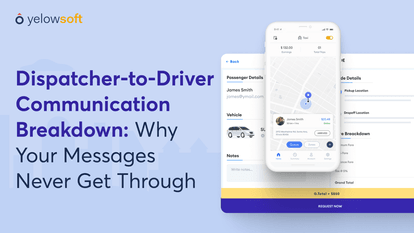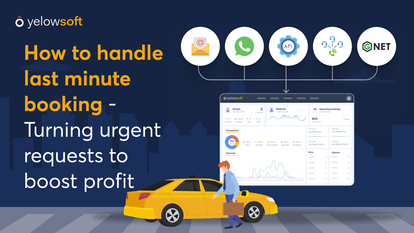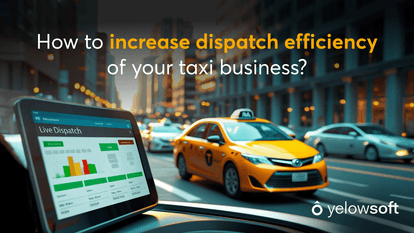Dispatching is crucial in all fleet management activities, regardless of the type of vehicles.
It evaluates the efficiency of resource utilization and the level of customer satisfaction.
Nevertheless, the process of creating a schedule is frequently plagued with obstacles that can interfere with operations.
Manual dispatch systems, despite being common and inexpensive in the beginning, have built-in restrictions.
They heavily depend on human involvement, causing delays, mistakes, and inefficiencies.
In contrast, dispatch systems utilize technology to simplify the process, providing quickness, precision, and flexibility.
This blog examines the main difference between manual vs. automated dispatch, with a focus on how automation addresses typical scheduling obstacles.
What is a manual dispatch system?
Manual dispatch means assigning drivers or vehicles using calls, notes, or spreadsheets. While manageable for small fleets, it fails to scale; dispatchers juggle calls, track drivers manually, and assign tasks by guesswork, causing inefficiency as operations grow.
Key challenges of manual dispatch:
- Human Error: With manual operations, errors can occur 2 out of every 10 times, leading to dissatisfied customers and revenue loss.
- Limited Efficiency: Manual handling can reduce efficiency by up to 40%, slowing down daily operations.
- No Data Insights: Without proper analytics, 9 out of 10 business decisions are based on guesswork, making growth unpredictable.
What is automated dispatch software?
Automated dispatch software leverages technology, algorithms, and live data to plan routes, assign drivers, and track progress with minimal human input. By factoring traffic, location, and capacity, it matches drivers to requests, integrating GPS, customer apps, and analytics for seamless operations.
Key benefits of automated dispatch software:
- Speed and Accuracy: Reduce dispatch time by up to 60% while minimizing human errors.
- Scalability: Handle 5x more bookings without increasing staff or costs.
- Data-Driven Insights: Make 90% of decisions backed by real-time analytics instead of guesswork.
Difference between manual and auto dispatch
Manual and automated dispatch for scheduled rides have notable differences in their approach to scheduling and managing resources. Here is a straightforward assessment of their skills.
| Scheduling Challenges | Manual Dispatch | Automated Dispatch |
|---|---|---|
| Efficiency | More time is consumed in assigning the trip and its completion. | Processes are instant and seamless. |
| Accuracy | High risk of human error. | Uses algorithms to minimize mistakes. |
| Scalability | Limited without adding more staff. | Effortlessly handles growing workloads. |
| Cost | Initially cheaper but costly as operations scale. | Higher initial investment, but cost-efficient long-term. |
| Customer satisfaction | Affected by delays and inefficiencies. | Enhanced through faster response times and reliability. |
| Resource Utilization | Slower response as dispatchers handle requests one by one. | Instant task allocation powered by algorithms. |
| 24/7 Operations | Dispatcher availability limits operations, prone to downtime. | The system runs around the clock with no interruptions. |
| Peak Hour Handling | Dispatchers get overwhelmed with a surge in demand. | Scales dynamically to handle peak loads smoothly. |
Automated dispatch systems are superior to manual methods, especially for businesses looking to expand and enhance service excellence.
Automated dispatch: Need of the hour
Businesses in various sectors are moving towards automated dispatch systems to address the constraints of manual processes and achieve a competitive advantage.
1. Improved efficiency and productivity
Automated scheduling software makes scheduling more efficient by assigning tasks based on real-time data. This reduces wait times, guarantees efficient resource allocation, and allows dispatchers to concentrate on important duties rather than routine tasks.
2. Enhanced customer satisfaction
Quicker response times, precise scheduling, and dependable service all enhance customer satisfaction. Automation helps to eliminate mistakes that could cause inconvenience to customers, such as delays in arrival or overlooked reservations.
3. Cost savings
When compared to manual dispatch costs, the upfront cost of implementing automated scheduling software for dispatching may be expensive, but it ultimately lowers expenses in the long run by enhancing efficiency, decreasing mistakes, and eliminating the necessity for extra dispatch personnel. Businesses cut costs by automating tasks, leading to savings in fuel, time, and resources.
4. Scalability and adaptability
Automated dispatch software is created to expand along with the company. These systems easily accommodate new vehicles, expand service areas, and manage increased customer numbers.
5. Data-driven insights
Automation allows for valuable data on fleet performance, driver efficiency, and customer behavior to be accessed. Businesses can utilize this information to make well-informed choices, enhance efficiency, and prepare for what lies ahead.
Conclusion
Manual dispatching may work for small setups, but it struggles with growth, speed, and accuracy. Today’s businesses need more than just familiar methods; they need solutions that can scale, integrate seamlessly, and provide real-time insights.
By choosing the right dispatch management software—one that is easy to use, flexible, feature-rich, and built for future expansion—you can eliminate inefficiencies, reduce errors, and deliver faster service.
Automated dispatch software doesn’t just improve scheduling; it boosts customer satisfaction, cuts costs, and gives you a competitive edge. The time for guesswork is over. Now is the time to shift to automation and future-proof your fleet operations.
Automate your operations with Yelowsoft’s automated dispatch software




